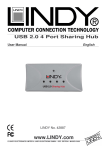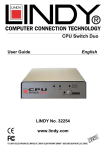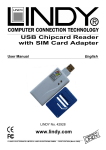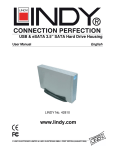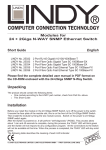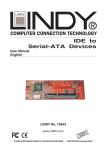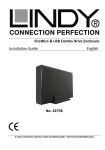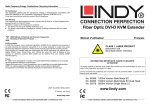Download Lindy 32916 Paper Shredder User Manual
Transcript
FireWire Repeater Hub 6 Port English User Manual LINDY No. 32916 www.lindy.com © LINDY ELECTRONICS LIMITED & LINDY-ELEKTRONIK GMBH - FIRST EDITION (March 2008) English User Manual Introduction The LINDY FireWire Repeater Hub adds IEEE-1394a compliant ports that support data transfer rates of 100, 200 and 400 Mbps, and automatically switch to the highest speed that the peripheral supports, to your computer. Package Contents LINDY FireWire Repeater Hub FireWire Cable Power Adapter (Multi-country) This manual System Requirements Pentium II Processor, 200MHz or above An available FireWire® (IEEE 1394) port installed on your computer MS Windows 98 SE/ME/2000/XP/Vista , Mac OS 8.6 and above Features Performs FireWire IEEE-1394 functions with high speeds of 100/200/400 Mbps Supports Hot Plugging and Hot Swapping IEEE 1394-1995 compliant and compatible with proposal 1394a Easy connection to your Digital camcorder, D8, scanner and Hard drives enclosures Supports up to 63 devices simultaneously through cascading multiple hubs 2 English User Manual Installation and Operation 1. Insert the supplied FireWire cable in to the port on the back of the LINDY FireWire Repeater Hub. 2. Connect the other end of the FireWire cable to an available FireWire port on your computer. 3. You may also attach the supplied power supply, though this should only be required for use with FireWire peripherals with high power consumption. No drivers are required to install the hub; however when you connect peripherals to your hub for the first time the Windows New Hardware Installation program will prompt you to install the software drivers for the peripheral. Follow the instructions in the User Manual that came with your peripheral to complete this process. Specification Specification LINDY FireWire Repeater Hub 6 Port Chips Texas Instruments IEEE-1394 Speed 100/200/400 Mbps LED Connector 1 IEEE-1394 6P Female X 6 3 Radio Frequency Energy, Certifications Shielded cables must be used with this equipment to maintain compliance with radio frequency energy emission regulations and ensure a suitably high level of immunity to electromagnetic disturbances. FCC Warning This equipment has been tested and found to comply with the limits for a Class B digital device, pursuant to part 15 of the FCC Rules. These limits are designed to provide reasonable protection against harmful interference in a residential installation. This equipment generates, uses, and can radiate radio frequency energy and, if not installed and used in accordance with the instructions, may cause harmful interference to radio communications. However, there is no guarantee that interference will not occur in a particular installation. If this equipment does cause harmful interference to radio or television reception, which can be determined by turning the equipment off and on, the user is encouraged to try to correct the interference by one or more of the following measures: Reorient or relocate the receiving antenna Increase the separation between the equipment and receiver Connect the equipment into an outlet on a circuit different from that to which the receiver is connected Consult the dealer or an experienced technician for help You are cautioned that changes or modification not expressly approved by the party responsible for compliance could void your authority to operate the equipment. This device complies with part 15 of the FCC Rules. Operation is subject to the following two conditions: 1. This device may not cause harmful interference, and 2. This device must accept any interference received, including interference that may cause undesired operation. WEEE (Waste of Electrical and Electronic Equipment), Recycling of Electronic Products In 2006 the European Union introduced regulations (WEEE) for the collection and recycling of all waste electrical and electronic equipment. It is no longer allowable to simply throw away electrical and electronic equipment. Instead, these products must enter the recycling process. Each individual EU member state has implemented the WEEE regulations into national law in slightly different ways. Please follow your national law when you want to dispose of any electrical or electronic products. More details can be obtained from your national WEEE recycling agency. LINDY No. 32916 1st Edition, March 2008 www.lindy.com




